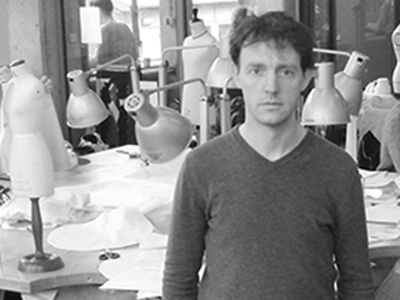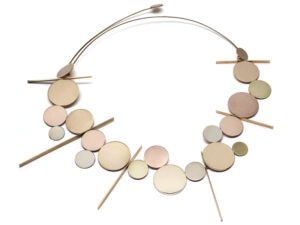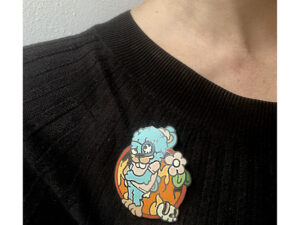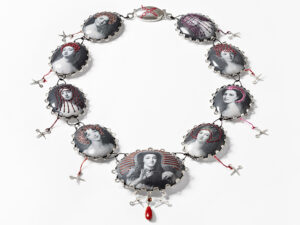![David Bielander, Wellpappe [Cardboard], 2015, bracelets, patinated silver, white gold, from left to right, 85 x 85 x 43 mm, 90 x 85 x 20 mm, 88 x 74 x 53 mm, 90 x 58 x 44 mm, photo: Dirk Eisel David Bielander, Wellpappe [Cardboard], 2015, bracelets, patinated silver, white](https://artjewelryforum.org/sites/default/files/images2015/david-bielander-cardboard/content/1x1remmelkampbielander1600px.jpg)
prototype
In 1912, a full-scale wood and canvas model of the never-realized van der Rohe proposal for the Kröller-Müller pavilion in Wassenaar was erected. The construction was photographed and destroyed soon after. Prototypes are incomplete versions of desired final executions that despite their defectiveness contain the characteristics necessary to form a reliable prefiguration. There must be something wrong with a piece mimicking its preceding prototype—a radical short-circuiting of chronology and hierarchy.
beggar king
Sandwiches, chicken, and beef are provided with grilled stripes to give consumers the illusion of an artisanal snack; char marks, they call them, fast food makeup. Makeup is used to mask and jazz things up. This phenomenon is rarely reversed; silver is seldom iron-plated. This piece is an exception and made me think of the story of the beggar king dressing up as a poor man in order to interrogate his citizens.
![David Bielander, Wellpappe [Cardboard], 2015, bracelet, patinated silver, white gold, from left to right, 85 x 85 x 43 mm, photo: Dirk Eisel David Bielander, Wellpappe [Cardboard], 2015, bracelet, patinated silver, white](https://artjewelryforum.org/sites/default/files/images2015/david-bielander-cardboard/content/1x1remmelkampbielander2600px.jpg) camouflage
camouflage
There are two general camouflage strategies. One either blends into the background, or one stands out with a false identity. Both aim to delude. This piece follows both strategies. It disguises its shiny silver appearance by adopting a matte and almost skin-color cardboard surface, and simultaneously it acts out a child’s rainy afternoon cut-and-paste endeavor proudly worn by a parent. Only its weight, sound, and temperature will reveal its true identity.
chemistry
A dynamic equilibrium is a situation in which the rate of forward reaction is equal to the rate of reverse reaction. At first glance such a situation seems like a static situation, but a closer look reveals constant transformation. Cardboard is turning into silver at the same rate as silver is turning into cardboard. The piece is caught in the middle, trembling between its two pure states. Cardboard at one end, silver at the other.
![David Bielander, Wellpappe [Cardboard], 2015, bracelet, patinated silver, white gold, from left to right, 90 x 85 x 20 mm, photo: Dirk Eisel David Bielander, Wellpappe [Cardboard], 2015, bracelet, patinated silver, white](https://artjewelryforum.org/sites/default/files/images2015/david-bielander-cardboard/content/1x1remmelkampbielander3600px.jpg) taste
taste
John Cage was anxious to go beyond his personal tastes, to overcome his own subjective choices. This led him to chance systems, to ways that allow his musical sounds to be selected by means that he could not directly control. Looking at the piece from this perspective, I understand the willy-nillyness of the form as a way to reduce focus on craftsmanship and style and make space for the conceptual signature of this self-made ready-made.
speed
An object contains its making process. It includes a unique sequence of successive gestures that lead to its existence. Sometimes the echo of this creative choreography lies at the surface; other times it seems polished away. The eye of an expert is then needed to enter and decipher. In this piece, the traces of manufacturing are illusions. They suggest different production speed and logistics, as does Hokusai’s chisel when it mimics a gentle and fluent brushstroke.
![David Bielander, Wellpappe [Cardboard], 2015, bracelet, patinated silver, white gold, from left to right, 88 x 74 x 53 mm, photo: Dirk Eisel David Bielander, Wellpappe [Cardboard], 2015, bracelet, patinated silver, white](https://artjewelryforum.org/sites/default/files/images2015/david-bielander-cardboard/content/1x1remmelkampbielander4600px.jpg) decadence
decadence
Art that shows symptoms of an era of decline, often characterized by extraordinary refinement of expression in the absence of inner strength, can be called decadent. This piece relentlessly flirts with decadence. It is haughty and refined and its inner strength tends toward that of hollow laughter. It celebrates a decline of value and thus problematizes desire. Its subversive virility and embarrassing humor demand a wearer, but what is the moral motivation for wanting one?
stapler
The white golden staple sits like a gemstone clenching its teeth right through the patinated surface. One can hear the sharp forceful crunching and gritting of the stapler when driving metal through metal. The pressure punches the surrounding area and leaves a slight dented surface. No further chafing rashes of the stapler’s piercing force are visible. What is this powerful yet ever so gentle tool that allows for such clean and surgical stapling of gold through silver?
![David Bielander, Wellpappe [Cardboard], 2015, bracelet, patinated silver, white gold, from left to right, 90 x 58 x 44 mm, photo: Dirk Eisel David Bielander, Wellpappe [Cardboard], 2015, bracelet, patinated silver, white](https://artjewelryforum.org/sites/default/files/images2015/david-bielander-cardboard/content/1x1remmelkampbielander5600px.jpg) counterfeit
counterfeit
Ingredients: corrugated cardboard (single wall board 3.3 mm), bronze and silver spray paint, cutting board, snap-off knife, stapler.
Instructions: In thin layers, spray your entire sheet of cardboard, alternating silver and bronze until you reach the desired effect. Let dry and repeat on the other side. Then, with composed negligence, cut off several strips 2.5 to 4 cm wide and approximately 25 cm long. Bring the ends together in one gesture and staple the overlapping ends.
what’s next?
When, in 1984, Albert Oehlen painted a self-portrait with a skull, he confronted himself with a problem. What to paint after such an archaic and definite piece that manifests itself as a final gesture? He answered it by painting a self-portrait with two skulls and later one with three. Cardboard seems to introduce a similar problem. It is conclusive and powerful and can only be answered by undermining its finite and conclusive nature.




